Speech & Language Processing 1st Edition(English, Paperback, James H. Martin, Daniel Jurafsky)
Quick Overview
Product Price Comparison
For undergraduate or advanced undergraduate courses in Classical Natural Language Processing, Statistical Natural Language Processing, Speech Recognition, Computational Linguistics, and Human Language Processing. An explosion of Web-based language techniques, merging of distinct fields, availability of phone-based dialogue systems, and much more make this an exciting time in speech and language processing. The first of its kind to thoroughly cover language technology - at all levels and with all modern technologies - this text takes an empirical approach to the subject, based on applying statistical and other machine-learning algorithms to large corporations. The authors cover areas that traditionally are taught in different courses, to describe a unified vision of speech and language processing. Emphasis is on practical applications and scientific evaluation. An accompanying Website contains teaching materials for instructors, with pointers to language processing resources on the Web. The Second Edition offers a significant amount of new and extended material. Salient Features Each chapter is built around one or more worked examples demonstrating the main idea of the chapter - Uses the examples to illustrate the relative strengths and weaknesses of various approaches. Methodology boxes included in each chapter - Introduces important methodological tools such as evaluation, wizard of oz techniques, etc. Problem sets included in each chapter. Integration of speech and text processing - Merges speech processing and natural language processing fields. Empiricist/statistical/machine learning approaches to language processing-Covers all of the new statistical approaches, while still completely covering the earlier more structured and rule-based methods. Modern rigorous evaluation metrics. Unified and comprehensive coverage of the field - Covers the fundamental algorithms of various fields, whether originally proposed for spoken or written language. Emphasis on Web and other practical applications - Gives students an understanding of how language-related algorithms can be applied to important real-world problems. Emphasis on scientific evaluation - Offers a description of how systems are evaluated with each problem domain. Description of widely available language processing resources. Text-specific website at www.cs.colorado.edu/~martin/slp2.html - Contains teaching materials for instructors and pointers to language processing resources on the Web. New to this Edition Seven new chapters that extend coverage to include: Statistical sequence labeling - Features a comprehensive introduction to hidden Markov models (HMMs) including the forward, Viterbi, and forward-backward algorithms, maximum entropy models, and┬Ā maximum entropy Markov models (MEMMs). Information extraction - Includes machine learning-based approaches to named entity recognition, relation detection and temporal processing. Question answering and summarization, including. Advanced topics in speech recognition, including. Speech synthesis, including


